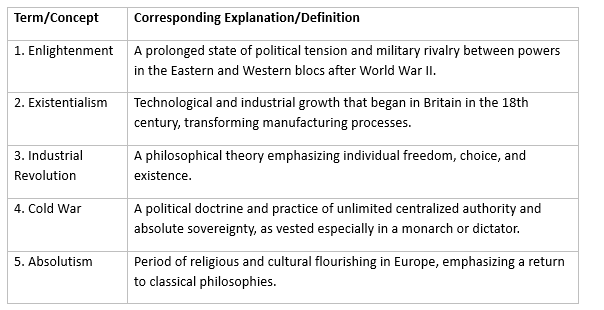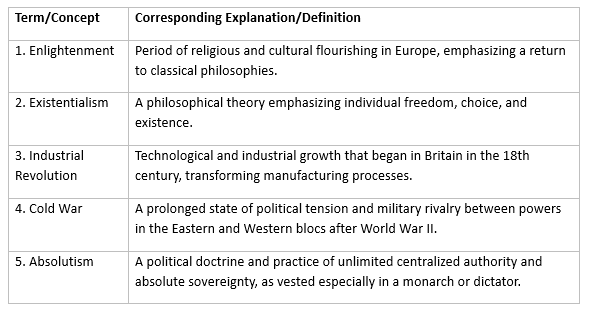Worksheet Solutions: Changing Cultural Traditions | History Class 11 - Humanities/Arts PDF Download
| Table of contents |

|
| Fill in the Blanks |

|
| Match the Column |

|
| Assertion and Reason Based |

|
| Very Short Answer Type Questions |

|
| Short Answer Type Questions |

|
| Long Answer Type Questions |

|
Fill in the Blanks
Q1: The term 'Renaissance' literally means _______.
Ans: rebirth
The Renaissance, derived from the French word for 'rebirth,' signified the revival of ancient Greek and Roman culture and ideas during the period.
Q2: Who is known as the 'Father of Humanism'?
Ans: Francesco Petrarch
Francesco Petrarch is recognized as the 'Father of Humanism' because he promoted the shift from the study of law to the study of ancient Roman culture and texts.
Q3: The Renaissance began in Italy and later spread to _______.
Ans: Florence, Rome, Venice, and Florence
Italy was the epicenter of the Renaissance, with Florence, Rome, Venice, and other cities playing a crucial role in its development.
Q4: The term 'Renaissance Man' is used to describe individuals with many interests and skills, often combining the roles of _______.
Ans: scholar-diplomat-theologian-artist
The Renaissance produced individuals with diverse talents and interests, often combining intellectual and artistic pursuits, and they were referred to as 'Renaissance Men.'
Q5: The fall of Constantinople to the Ottoman Turks in 1453 had a significant impact on _______.
Ans: trade with the East
The fall of Constantinople disrupted trade routes, making trade with the East more difficult and leading to changes in economic life in Europe.
Q6: The invention of the printing press is credited to _______.
Ans: Johannes Gutenberg
Johannes Gutenberg is credited with inventing the first printing press in 1455, which revolutionized the production of books and the spread of knowledge.
Q7: The Reformation movement in the sixteenth century led to the churches in _______ breaking their connection with the Pope and the Catholic Church.
Ans: Germany and Switzerland
The Reformation movement, led by figures like Martin Luther, resulted in the establishment of Protestant churches in various regions of Europe, including Germany and Switzerland, which severed ties with the Catholic Church.
Q8: Martin Luther's campaign against the Catholic Church in 1517 is known for his publication of _______.
Ans: the 'Ninety-Five Theses'
Martin Luther's campaign began with his posting of the 'Ninety-Five Theses' on the door of the Castle Church in Wittenberg in 1517, which critiqued the Catholic Church's practices and led to the Reformation.
Match the Column

Ans:
Assertion and Reason Based
Q1: Assertion: Renaissance marked a revival of ancient Greek and Latin culture.
Reason: Renaissance began in Italy and later spread to Rome, Venice, and Florence.
(a) Both Assertion and Reason are true, and Reason is the correct explanation of Assertion.
(b) Both Assertion and Reason are true, but Reason is not the correct explanation of Assertion.
(c) Assertion is true, but Reason is false.
(d) Both Assertion and Reason are false.
Ans: (a)
The Assertion correctly states that Renaissance marked a revival of ancient Greek and Latin culture. The Reason provides additional context, explaining that the Renaissance began in Italy and later spread to other Italian cities, supporting and explaining the Assertion.
Q2: Assertion: The fall of Constantinople to the Ottoman Turks had a significant impact on Renaissance.
Reason: Trade with the East became difficult after Constantinople's fall, leading to changes in the economic life.
(a) Both Assertion and Reason are true, and Reason is the correct explanation of Assertion.
(b) Both Assertion and Reason are true, but Reason is not the correct explanation of Assertion.
(c) Assertion is true, but Reason is false.
(d) Both Assertion and Reason are false.
Ans: (a)
The Assertion accurately points out that the fall of Constantinople had a significant impact on Renaissance. The Reason provides further information, stating that trade with the East became difficult after Constantinople's fall, which is a direct consequence of the event and explains the Assertion.
Very Short Answer Type Questions
Q1: What is the meaning of the term 'Renaissance'?
Ans: The meaning of the term 'Renaissance' is 'rebirth.' It denotes the revival of ancient Greek and Roman culture and ideas.
Q2: Who is known as the 'Father of Humanism'?
Ans: Francesco Petrarch is known as the 'Father of Humanism' for advocating the shift from the study of law to the study of ancient Roman culture and texts.
Q3: Which Italian cities were at the center of the Renaissance movement?
Ans: The Italian cities at the center of the Renaissance included Florence, Rome, Venice, and Florence.
Q4: How did the fall of Constantinople impact trade?
Ans: The fall of Constantinople to the Ottoman Turks disrupted trade with the East, making it more difficult and affecting economic life.
Q5: Who is credited with the invention of the printing press?
Ans: Johannes Gutenberg is credited with inventing the first printing press in 1455.
Q6: What was the Protestant Reformation, and who initiated it?
Ans: The Protestant Reformation was a movement initiated by Martin Luther in 1517, which led to the establishment of Protestant churches in various regions of Europe.
Q7: How did Martin Luther challenge the authority of the Catholic Church?
Ans: Martin Luther challenged the authority of the Catholic Church by posting his 'Ninety-Five Theses' in 1517, critiquing the church's practices.
Q8: What was the Counter Reformation Movement?
Ans: The Counter Reformation Movement was initiated by the Catholic Church as a response to the Reformation, aiming to reform and address some of its practices.
Short Answer Type Questions
Q1: Describe the role of Italian universities in the Renaissance movement.
Ans: Italian universities played a vital role in the Renaissance by becoming centers of legal studies and promoting the study of ancient Roman culture and texts. They contributed to the development of humanism and a shift in educational focus.
Q2: Explain the impact of the printing press on the spread of education.
Ans: The printing press revolutionized the spread of education by making books and prints more accessible to people. It allowed for the mass production of books, lowering their cost and enabling a wider audience to access knowledge.
Q3: Discuss the causes and consequences of the Reformation movement.
Ans: The Reformation movement was caused by the autocracy of the Catholic Church and Catholic corruption. Martin Luther and others challenged the authority of the church, leading to the establishment of Protestant churches. The movement also prompted reforms within the Catholic Church.
Q4: How did Renaissance change the perception of individuality and citizenship?
Ans: The Renaissance changed the perception of individuality and citizenship by gradually separating the 'private' and 'public' spheres of life. Individuals gained distinct roles in both areas, and this sense of individuality would later lead to the belief in equal political rights in the eighteenth century.
Q5: What were the key developments in Europe during the Renaissance and Reformation periods?
Ans: Key developments during the Renaissance and Reformation included the revival of ancient culture, the invention of the printing press, scientific advancements, changes in religious practices, and the emergence of a sense of regional identity based on language.
Long Answer Type Questions
Q1: Renaissance played a pivotal role in shaping the cultural traditions of Europe. Discuss the causes and effects of the Renaissance movement, emphasizing its significance in the transition to the Modern Age.
Ans: The Renaissance was a pivotal period that marked the shift to the Modern Age. It was defined by a revival of ancient Greek and Roman culture. Key causes included:
- Increased contact between East and West.
- The fall of Constantinople.
- The decline of feudalism.
- The rise of trade and a new middle class.
This movement changed how individuals viewed themselves, promoting personal development and individuality. The Renaissance also:
- Spread humanism.
- Introduced the printing press.
- Advanced rationalism and science.
Overall, it significantly influenced Europe's cultural and intellectual landscape, laying the foundation for the Modern Age.
Q2: The Reformation movement in the sixteenth century challenged the authority of the Catholic Church and led to significant religious and societal changes. Explain the causes, key figures, and consequences of the Reformation movement, including the Counter Reformation.
Ans: The Reformation, a religious movement in the sixteenth century, arose from various causes, including the corruption within the Catholic Church, the sale of indulgences, and the desire for personal faith. Humanist scholars, like Erasmus, criticized the Church's practices, advocating for a return to original texts and simpler worship.
- Key Figures:
- Martin Luther: His 1517 Ninety-Five Theses challenged Church authority and emphasized salvation through faith alone.
- Ulrich Zwingli and John Calvin: They furthered Reformation ideas in Switzerland, promoting reforms in church governance and doctrine.
- Ignatius Loyola: Founded the Jesuits in response to Protestantism, emphasizing education and missionary work.
The consequences of the Reformation were profound, leading to the establishment of Protestant churches, significant religious conflicts, and the Catholic Counter-Reformation aimed at reforming the Church from within. This movement reshaped European society, promoting individual interpretation of scripture and diminishing the Catholic Church's influence.
|
27 videos|125 docs|20 tests
|















